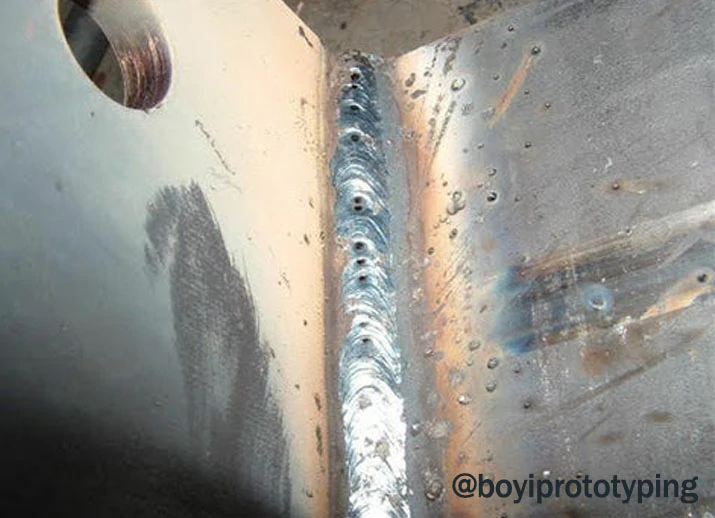Expert Recommendations on What is Porosity in Welding and Just How to Address It
Comprehending Porosity in Welding: Checking Out Causes, Results, and Avoidance Strategies
As professionals in the welding market are well mindful, comprehending the causes, results, and avoidance methods related to porosity is essential for attaining robust and reliable welds. By delving right into the origin creates of porosity, examining its harmful results on weld quality, and checking out efficient avoidance strategies, welders can boost their understanding and skills to create premium welds consistently.
Typical Causes of Porosity
Contamination, in the kind of dirt, oil, or corrosion on the welding surface, creates gas pockets when heated up, leading to porosity in the weld. Incorrect securing occurs when the securing gas, typically made use of in processes like MIG and TIG welding, is unable to fully secure the molten weld pool from responding with the surrounding air, resulting in gas entrapment and succeeding porosity. Additionally, inadequate gas insurance coverage, usually due to wrong circulation rates or nozzle positioning, can leave parts of the weld unsafe, enabling porosity to create.
Effects on Weld High Quality
The existence of porosity in a weld can dramatically endanger the total top quality and stability of the bonded joint. Porosity within a weld produces voids or tooth cavities that compromise the framework, making it more susceptible to cracking, corrosion, and mechanical failure.
In addition, porosity can prevent the efficiency of non-destructive screening (NDT) techniques, making it testing to find various other flaws or discontinuities within the weld. This can cause significant security problems, particularly in essential applications where the structural stability of the bonded elements is extremely important.

Avoidance Techniques Review
Provided the detrimental effect of porosity on weld high quality, reliable prevention strategies are essential to preserving the structural honesty of welded joints. Among the key avoidance techniques is complete cleaning of the base products prior to welding. Pollutants such as oil, grease, corrosion, and dampness can add to porosity, so making sure a clean work surface area is essential. Appropriate storage space of welding consumables in dry problems is additionally important to protect against wetness absorption, which can bring about gas entrapment during welding. Furthermore, picking the appropriate welding specifications, such as voltage, existing, and travel speed, can assist decrease the risk of porosity formation. Making sure ample shielding gas flow and insurance coverage is an additional crucial avoidance strategy, as not enough gas coverage can result in atmospheric contamination and porosity. Appropriate welder training and certification are necessary for executing preventative procedures properly and continually. By incorporating these prevention techniques into welding practices, the occurrence of porosity can be significantly decreased, resulting in more powerful and more dependable welded joints.
Relevance of Appropriate Protecting
Appropriate shielding in welding plays a vital role in look at this website preventing atmospheric contamination and guaranteeing the stability of welded joints. Securing gases, such as argon, helium, or a blend of both, are typically used to protect the weld pool from reacting with components in the air like oxygen and nitrogen. When these reactive components enter call with the warm weld swimming pool, they can create porosity, bring about weak welds with lowered mechanical residential or commercial properties.

Inadequate securing can result in numerous problems like porosity, spatter, and oxidation, endangering the structural honesty of the welded joint. Therefore, sticking to proper securing techniques is necessary to produce premium welds with marginal defects and make certain the longevity and integrity of the welded elements (What is Porosity).
Tracking and Control Approaches
Exactly how can welders properly monitor and control the welding procedure to guarantee optimum results and prevent issues like porosity? One key method is via using sophisticated surveillance technologies. These can include real-time monitoring systems that give responses on specifications such as voltage, present, take a trip speed, and gas circulation rates. By continuously keeping an eye on these variables, welders can recognize deviations from the perfect conditions and make instant changes to avoid porosity formation.

In addition, implementing proper training programs for welders is necessary for checking and controlling the welding process efficiently. What is Porosity. Informing welders on the relevance of maintaining regular criteria, such as appropriate gas shielding and take a trip rate, can help stop porosity concerns. Regular evaluations and qualifications can also guarantee that welders excel in monitoring and managing welding procedures
Furthermore, making use of automated welding systems can improve monitoring and control capacities. These systems can precisely regulate welding parameters, minimizing the possibility of human mistake and making sure regular weld top quality. By incorporating innovative tracking innovations, training programs, and automated systems, welders can effectively monitor and control the welding procedure to decrease porosity use this link problems and home achieve premium welds.
Final Thought
